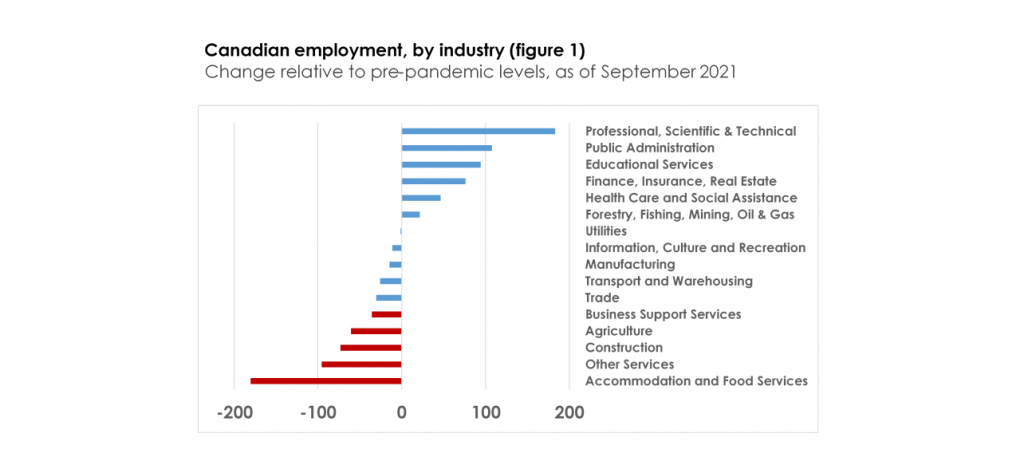Blog /
Finishing the fight against COVID-19: the wage and rent subsidy support programs for the hardest hit sectors
Finishing the fight against COVID-19: the wage and rent subsidy support programs for the hardest hit sectors
The on-the-ground reality is that we are still far from normal business operations, and the majority of businesses continue to struggle.

October 21, 2021
Key Points
- The COVID-19 pandemic is not over. Ongoing public health measures and travel restrictions, have significantly reduced the capacities of many businesses, whose operations will once again be viable after the pandemic.
- Facing these continued public health restrictions and a highly volatile and uncertain outlook, support should continue for the hardest hit sectors that still face situations far worse than those experienced for other sectors during the depths of the Global Financial Crisis in 2008-09.
- Ending government support programs prematurely would be self-defeating, leading to waves of job loss and unnecessary hardship that would hamper the ability of Canada’s economy to fully recover after public health measures are lifted.
The COVID-19 pandemic hit the global and Canadian economies much more severely than previous cyclical downturns. In the early days of the pandemic, many economic activities were effectively halted to preserve public health during broad-based lockdowns. While many of these restrictions have started to loosen, the pandemic is far from over, and several sectors, including the travel, hospitality, and tourism sectors still face significant capacity restrictions and depressed demand due to ongoing public health measures. These operating restrictions are in addition to border measures such as a blanket government advisory against non-essential travel and expensive PCR testing requirements even for fully vaccinated travelers.
The on-the-ground reality is that we are still far from normal business operations, and the majority of businesses continue to struggle. In Statistics Canada’s 2021Q3 Canadian Survey on Business Conditions (undertaken in July and August 2021), almost one-in-five businesses (19%) reported that they cannot take on any more debt, primarily due to concerns about cash flow and elevated uncertainty about future sales. Perhaps not surprisingly, corporate debt constraints for companies are highest in the hardest hit sectors including: accommodation and food services (27%); and arts, entertainment and recreation (26%).

According to the Canadian Federation of Independent Business, most small businesses (60%) continue to operate below pre-pandemic sales levels, while 55% are not fully staffed, and one-in-four are not even fully open for business. We are seeing this pain acutely in the hardest-hit sectors, where employment and real GDP remain well below pre-pandemic levels, as illustrated in figures 1 and 2. The situation remains dire indeed with employment still more than 10% below pre-pandemic levels in sectors that are difficult to physically distance, such as accommodation and food service (-15%, or 180,300 jobs); and “other services” (-12% or 95,500 jobs). During the depths of the Global Financial Crisis in 2008-09, the worst comparable sectoral employment declines were less severe than those currently impacting these sectors.
Given the sustained and disproportinate impact of COVID-19 on these struggling industries, the Canadian Chamber’s What it Takes to Grow platform called for the federal government to extend retooled versions of the wage and rent subsidy programs through to Spring 2022, during the time that public health measures are expected to continue to restrict these companies from operating at full capacity.

The rationale for programs such as the wage and rent subsidy is to prevent a wave of bankruptcies for companies that are profitable in non-pandemic times, but that have been forced — temporarily and for an uncertain period of time — to suspend their operations or operate at a reduced capacity in compliance with government restrictions to ensure public health and safety.
The CEWS program has maintained thousands of existing productive relationships between workers and their businesses. Prematurely ending these programs, while the pandemic continues, would cause businesses to have to lay off their employees, at a time when there are already 389,000 Canadians that are long-term unemployed and looking for work. This risks a situation where yet more workers’ skills atrophy as they become detached from their previous jobs or the labour market all together. The structural separation of additional employees and their former employers would prevent the economy from achieving a full recovery after the pandemic.
It also vital to not lose sight of the seasonal nature for many businesses in the hardest hit sectors given these businesses will lose a large portion of their revenue over the winter months without the counterbalancing of have had a tourism season in 2021. Businesses operators, such as a hotel, cannot repurpose their facility for other uses in the off-season. Chart 1 provides an example of the criticality of the support programs for the hardest hit sectors.

Related News

Time to put reports into action, Chamber tells House Agriculture Committee

2022 Q3 Canadian Survey on Business Conditions: Inflation is the top issue. Labour pains intensifying, but price pressures and supply chains issues are improving




